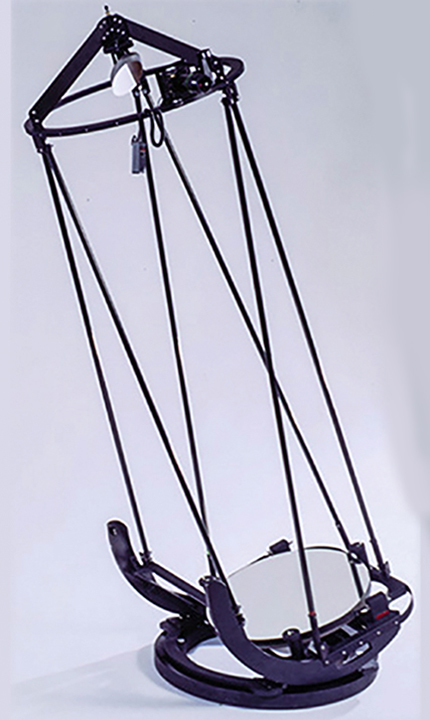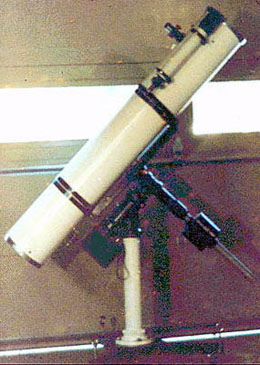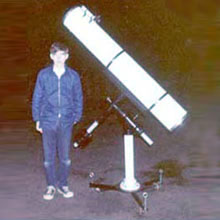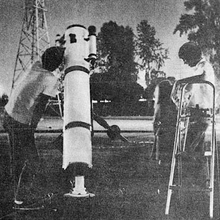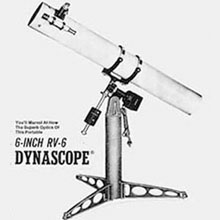|
My Astronomy Website
- My Telescopes stargazingnow.comm by Greg Babcock |
Home Telescopes Binoculars Imaging Gallery Venues |
| My Newest Telescope 14.5 inch f/3.5 Grab & Go Telescope (custom) |
 |
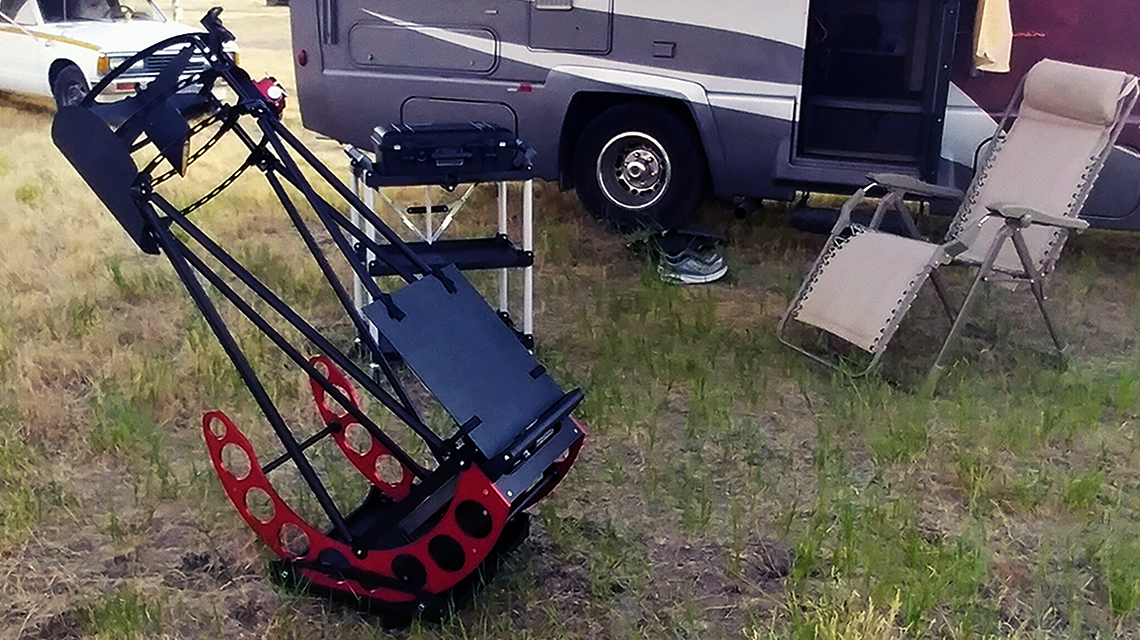 |
 |
|
|
|||||||||
|
. |
First Light: March 17th, 2017
This Telescope represents an effort to go smaller and lighter, but still provide enough light gathering power to provide Deep Sky enjoyment. This Telescope was built to replace the 20 inch f/3.55. This is an Aluminum Telescope with a few plastic components. There is no dought, I miss the larger aperture Telescopes. But the smaller Telescope gets used more often. This new Telesscope is compact enough to travel fully assembled in a compact car. The Optical Tube Assembly (OTA) weighs 55 pounds and can be lifted by one person off the Rocker/Base. For me, being able to move the Telescope without a complete take down and re-setup is an important feature. Further, no ladder is required. The eyepiece height is about the same as an 8 inch f/6 Dobsonian. At Star Parties, sudden storms or late arriving RV neighbors blocking your horizon views have been problem-matic once I have been setup. Also, trees in a wooded site create the need for a quick relocation as I would track and follow objects. Not to mention, I can only wonder how many times, I did not go out due to setup hassels. All, hopefully gone now. Transporting Telescopes inflicts the most wear and tear on these instruments. The small Scope travels well and is easy to protect in a vehicle. Camping gear competing for space and/or falling on to the Telescope, is a lessor issue. Influencing the smaller scope choice was the memory of the 2006 Oregon Star Party (OSP). The 10 inch Travel Scope was brought to show at the Telescope "Walk-a-bout". There was no observing plan, but later that night, it was improvedly used to tour the sky wih ease. It was easily moved from under a protective awning to the observing area and back again. Another factor of influence to go smaller was the enjoyment Mel Bartels had with his smaller Scopes and their wide fields. His 13.1 inch started as a desgin study for a larger scope. Instead, it inspired him to make two still smaller Telescopes, a 10 and 6 inch super fast Telescopes. The larger field of view is a trade-off gain. The 21mm Ethos, with a Paracorr (P2) provides a 1.42 degree field of view at 71x. Locating objects is easier. The 4.7mm Ethos with P2 provides 315x. M13, is the benchmark object for determining performance. Observing it at 315x provided an unexpectidly stunning view. Another "benchmark" Object is NGC 4565. The dark cloud is easily seen. I routinely use a 7mm XW Pentax at 212x to observe it. Another object is NGC 891, beautiful at 247x. The key is to fine tune the Telescope's performance with the right eyepiece selection. I rarely went over 300x with the 20 and 24 inch Telescopes. I found that sky conditions rarely permited it. Touring the sky at the 2017 Golden State Star Party (GSSP) demonstrated that this Telescope exceded my expectations. Fabrication by: Strassburg Machining of Hillsboro, Oregon phone: 971-219-2995 |
|
Design Features: The Cage-much of the design features are here. Flexible mounting of Cage for Left or Right Eye use, 3 ring Cage sandwiches focuser between rings for high eyepiece payload capability, 2 Finder Mounting Shoe option to allow for a possible Laser Pointer-important for a low height Telescope. Also user choice to mount the Finder for the left or right eye, The Spacers between the Cage Rings have a large surface area to prevent racking. They are bolted to the Rings and the Truss Brackets. The Spacers are slotted to allow Finderscope Shoes to be mounted to them and to reduce weight. The Spider is also mounted in the slots. The slots allow the Spider to be adjusted for alignment. In addition, the Cage Light Shield is also mounted to these spacers. Holes in the Cage Rings reduce weight and wind resistance. Inside dimensions of the Cage Rings are only 1/4 inch larger in radius then the Mirror radius to improve contrast and reduce excess material. Mirror Box "North End" accepts screw in feet to allow it to stand up-right (like a suite case) durring transport including possible flying. Ridges on the inside box allows covers to me flush mounted over the box for further protection for storage or travel. Adjustble Tension Roller Bearings for Altitude Bearing. Counter-weights are not necessary, The Alt-Bearings are tall to provide a lot of surface contact to the Mirror Box to prevent racking. 1.75 inch tall feet for height and rocky terrain ground clearance, Grab Rail for easy pickup and Transport, 17.75 inch maximum outside diameter of Cage allows the Telescope to pass through an RV door. Sized to fit in a small vehicle assembled. The "Moonlight" Focuser's large easy to see knobs are ideal for guest observers. |
||||||
|
|
Why the 14.5
inch Size? Several sizes were considered, but non larger than the 14.5 inch. I seriously considered a 10 inch. At f/3.5 it would give a 2.1 degree field of view with a 21mm Ethos Eyepiece and Paracorr. Ultimately I chose the 14.5 inch as a comprimise between Aperture and Field of View. Further, the 14.5 inch Mirror Cell was the largest non-custom Mirror Cell produced by Aurora Precision. In designing a Telescope, I try to minimize the number of custom parts. Aurora (Nathan Currier) makes an excellent product. This Telescope was also an opportunity to show case his components. This Telescope was built by "Joe Strassburg Machine". Primary Mirror by Steve Swayzee and many components by Aurora Machine. Astro Systems provided the Spider and Secondary. The Focuser is a "Moonlight" brand. Why f/3.5? While the development of the Coma Corrector is making the "Short Focus" Telescope a popular choice, there are draw backs. Difficult to focus and large Secondary Mirrors are to name a couple. I choose the f/3.5 as a comprimise. With a Paracor-2 (P2), the Telescopes yields f/4. A 20mm Eyepiece provides a 5mm Exit Pupil. I think it is an optimin size for achieving light and contrast. The 21mm Ethos provides a 5.2mm Exit Pupil. The shorter Focal Lengths were intended to place the Eyepiece more within reach of the Observers Eyes without the aid of a ladder. It isn't as necessary for a 14.5 inch, but it aids in the portablility department. The assembled Telescope Tube can fit into a small car. |
|
Altitude Bearing Styling The large Red Altitude Bearing is a dominating physical signature feature of the Telescope. This was somewhat intentional to create styling. It is even about 3 inches longer than necessary to do the job. Typically I would not allow this because of the added weight, but it gives the Telescope an elegant look. Circles and circular holes give the Telescopes its design theme. |
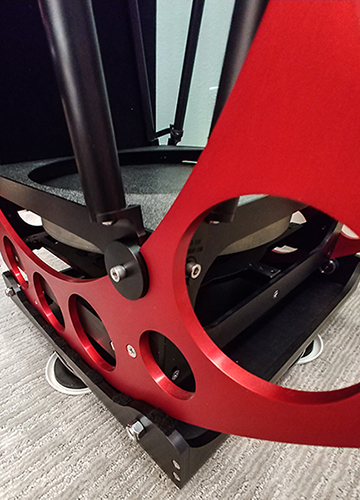 |
|||||
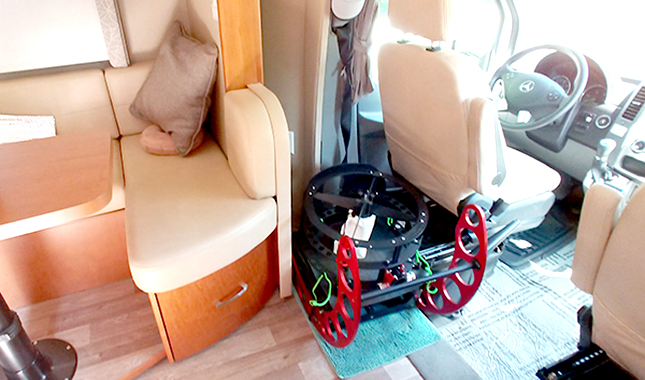 |
Left Image: Travels
well in a small motor home. Right Image: Ralf Nye's monster 14.25 inch f/7 Telescope featured in a 1970's Sky & Telescope article. The scope towers over it's builder. The 14.5 f/3.5 requires a chair, not a ladder, to observe through it comfortably. The new scope highlights the dramatic evolution of Telescope designs. |
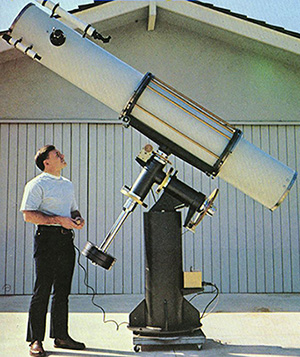 |
|||||||
|
|
|
|
| Grab & Go 8.2 inch f/3.9 | ||
|
|
The Explorer Scientific 8.2
inch Telescope is a Telescope I have been considering for years. Its price, carbon tube and light weight made it the choice of many available in this size. With a 31mm Nagler Eyepiece and a Paracorr-2 (P2) the Telescope will yeilds a very large 6.9mm Exit Pupil and a very large 2.73 degree feild of view. The Telescope was modified to make it unique and more functional. 1.] Tube was shortened by 2 inches to make it 28 inches. This combined with it's 9.5 inch Tube make it a potential carry on Traveler. This might be wishful thinking. 2.] The Focuser was replaced with a "Moonlite" red Focuser for commonality with the 14.5 inch Telescope and to, perhaps, give it a "trademark" look. The Focuser also reduce the weight slightly and the Focuser's height is 1 inch shorter then the previous one, giving it a lower profile for Travel. It ijust seems to a better Focuser anyway. The lower profile Focuser makes an extension tube necessary for visual use. 3.] The heavy handle on top was replaced with a lighter rubber one. The previous handle was designed to mount a Camera on it. 4.] Finally, the Finderscope Mounting Bracket was changed to accept the same bracket that is on my other Telescopes. My first Telescope was behemoth 135 pounds, 8 inch f/7.2. This Optical Tube Assembly (OTA) may be less than 20 pounds on a 15 pound Tripod. How easy it would have been to take this scope to the early Star Parties when I was 16 years old. The 8 inch was my first serious Telescope. I have gone full circle, in a sense. |
|
|
ES 8.2 inch with "Moon-Lite" Focuser retro-fitted. |
||
| More to Come on the 8.2 inch. | ||
|
|
| Televue 76mm f/6.3 APO Refractor Telescope (TV76) | ||||||
 Images by the TV76 Venus Transit 2012 Annualar Eclipse 2012 Solar Eclipse 2009 Venus Transit 2004 |
Ordered: September 2001 This was number 31 off the assembly line. This scope was orderd at the 2001 Mt. Bachelor Star Party. The 76mm gets the most variety of assignments. It was fitted with a Coronado H-Alpha Solar Filter by Coronado (shown left). The 8-24mm Zoom Eyepiece gives 20x-60x for Solar Viewing. The APO design makes the 76 excellent for Planetary and "Rich Field" viewing. The 76mm is the size of the old 70mm Pronto and fits in an "under the seat" airline carry on case. It went to the Venus Transit in 2004 and the Solar Eclipse in 2009 to image these events. It also Imaged the 2012 Annular Eclipse and the 2012 Venus Transit. The Takahashi Teegul Mount This is the only Tracking Mount that I own. I acquired it in 2003. It is accurate, compact and an excellent traveler. It uses custom made solid Aluminum "Latitude" Wedges" machined to 30 & 45 degrees. They are interchangeable depending on the Telescopes travel destination. They can be stacked to give Latitudes from 15 degrees up to 75. Latitude Fine tuning is achieved by adjusting the Tripod legs. The "C" Cell Battery pack was replaced by a lighter "AAA" battery pack. For the 2009 eclipse, the counterweight shaft and Latitude wedges were left off to make the Mount a lighter "Alt-az" since ship board observing did not require an Equatorial Mount. This mount has carried Telescope as large as the TV85mm. It will be permanently configured as a traveler, loosing the counterweight. It will carry the Sharp Star 61 or the Sony a6000 with a 135mm F/2 Camera Lens. |
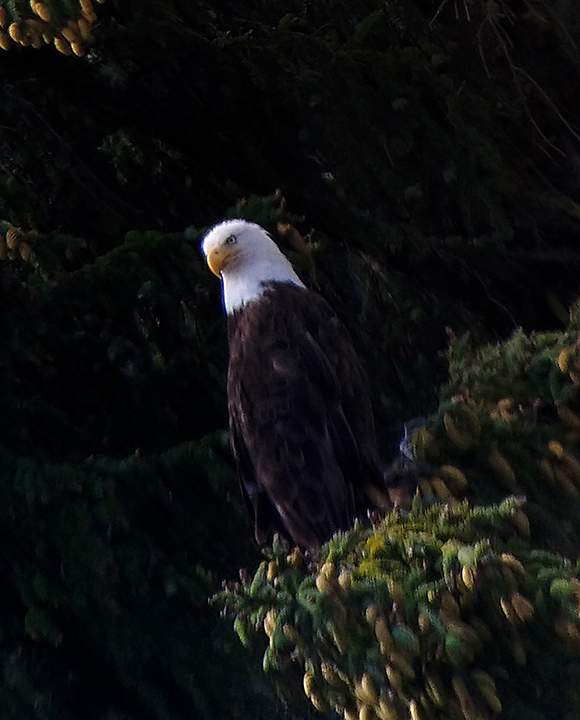 |
||||
| Images Right: Bald Eagle from 2000 feet away viewed from near Pacific City Oregon at Clay Meyers Park on Whalen Island. Two Bald Eagles live in a grove of trees across Sand Creek. Image taken through a TV 76 with a 6mm Ethos eyepiece using a hand held phone camera. The pupil of an Eagle is roughly the same diameter as he human eyes. |
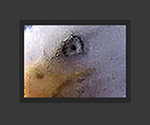 |
|||||
| . | ||||||
| Canon 10x42 Image Stabilizing (IS) Binoculars | |||||
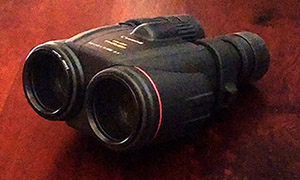 |
Acquired March 2014.
Normally, I wouldn't list Binoculars
as a Telescope, but these are often used for their "grab and go" qualities. No tripod or setup
is required to observe. The image stabilizing
features eliminates the jiggling motion and gives a "floating effect." These Binoculars have been fitted with filter adapters, that allow me to attach a UHC filter for observing objects like the North American Nebula and Veil Nebula. I only put the filter on one lens and let the high contrast, view balance with the natural view. |
These Binoculars provide a 6.5
degree field of view making objects easier to located. It has a
decent 4.2mm Exit Pupil and its compact size and relatively
light weight, makes it easier to hold. The 15x50 Canon IS were
an attractive consideration for their power, but the 10x42s size
weight, exit pupil and field of view won out.
|
|||
| . | |||||
| . | |||||
|
Telescope Page Menu |
|
My
Current Telescopes
My Past Reflector Telescopes
My Trend Settting Dobs
My Past Refractor Telescopes for Beginners Amatuer Telescope Links |
|
|
|
|
| My Current Telescopes (cont'd) | Telescopes in the Family |
| National Geographic 76mm f/4.6 |
|
|
This Telescope was purchased for my Grandson Sam,
kid model in
my Book.
It is a nifty little Scope. The Optical Tube Assembly (OTA) has
a star map on it, reminiscent of the Questar Telescope. The Base holds a Compass.
The Setting Circles on the side and Compass are not really
useful, but they add flare.
|
|||
| . | ||||
|
Telescope Page Menu |
|
My
Current Telescopes
My Past Reflector Telescopes
My Trend Settting Dobs
My Past Refractor Telescopes for Beginners Amatuer Telescope Links |
|
|
|
|
|
My Past Reflector Telescopes |
| 20 inch f/3.55 Dobsonian (custom) | First Light: January 7th, 2011 |
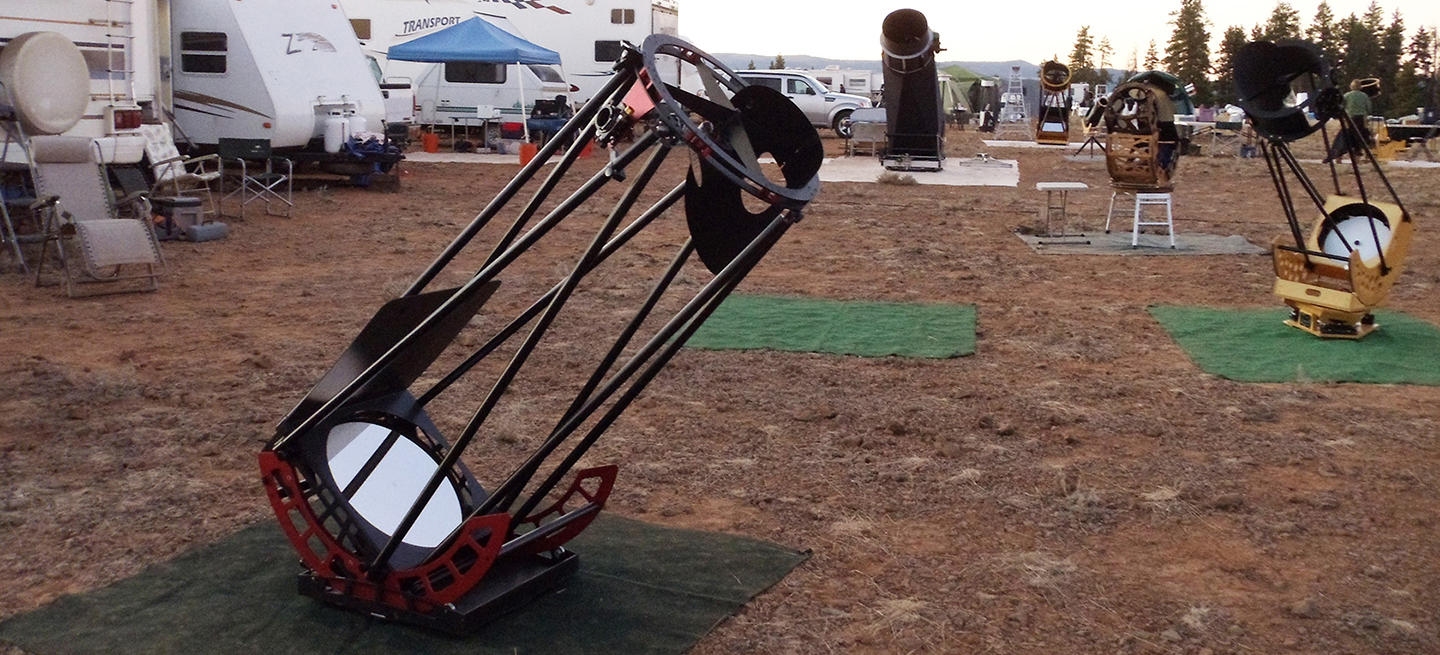 |
|
|
.20 inch f/3.55 Telescope at the September 2011 Oregon Star Party .. |
|
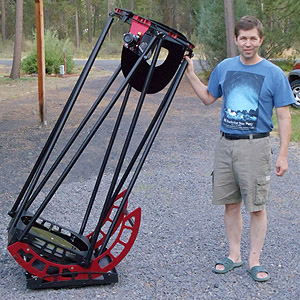 |
This Telescope was designed by (me) Greg Babcock and Nate Currier of
Aurora Precision and built by Aurora Precision.
It was built mostly out of
Aluminum. Many components were "off the shelve" products
including the Truss Clamps, The Astro-Systems Spider features a heated Secondary Holder.
The Mirror is 1-5/8 inch thick Pyrex made by Swayze Optical. The goal with the new scope was to increase ease of use and mobility. It was patterned after the 12 inch Traveler. A lot of the anxiety comes from transporting the scope. The 12s hard Baltic Birch Mirror Box protects the scope during transport. The 20s aluminum Mirror Box Case does the same. The 20's heaviest piece is the Mirror Box, 65 pounds, its physically small (22.25 inches square), adding to the ease of handling. To assemble, the Mirror Box can be lowered between the lock-able Alt-Bearings onto a guide track. The height of the 20 permits attaching the Cage, and viewing, without a ladder. And no ladder is required for observing. The Mirror Box easily goes through a narrow RV door and travels well in the small vehicles. |
The Cage design features 2 thin "Alucobond" rings, with Aluminum
spacers. Tension from the Spider gives the Cage torsion strength. This
strong Cage is attached directly to the Trusses. A del-ran Bridge
between a Truss and Focuser Board, supports and stabilizes the Focuser
Board. It replaces what would have been an additional
Cage ring. A
20.25 inch Light Baffle just in front of the Primary Mirror and Cage
rings only 21 inches in
diameter, add contrast to the view. The physical Size of the Scope
is closer to that of an 18 inch. The Telescope weighs 114 pounds. The Images don't do this Telescope justice. The architecture could be described as an industrial look. The red accent enhances the appearance. Top Image note: At September 1st., 2011 Oregon Star Party (OSP). From Left to Right, My 20 inch f/3.55, Howard Banich 28 inch f/4 with black shroud, Mel Bartels 13 inch f/3 on aluminum stand. Dave Danskey's 16 inch on Equatorial Platform (right). |
||
| Above image Is the first "operational" use; August 26th, 2012 in Central Oregon. First Light January 7th, 2011 5:40pm-Cresent Moon. |
| . | |
| 12 inch f/4.9 Traveler (custom built-homemade) |
First Light-March 30th,
2008, 9:00pm - Orion Nebula Sold in 2015 |
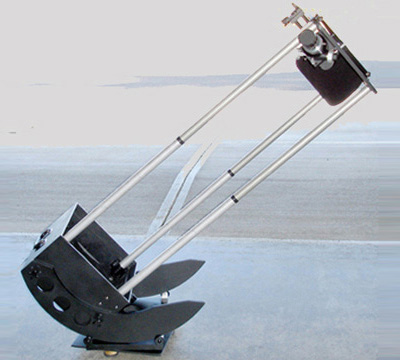 |
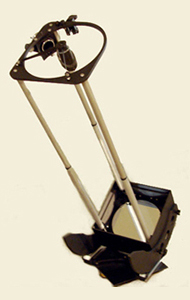 |
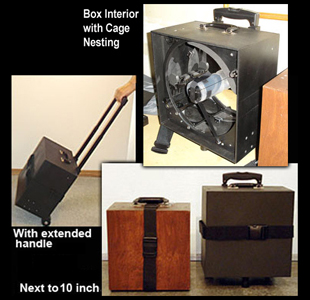 |
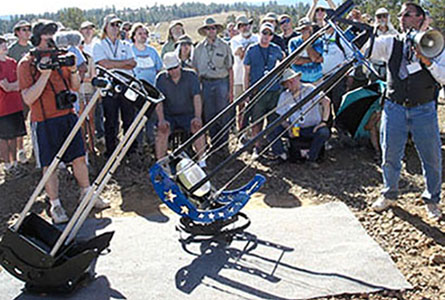 |
|||
|
The Carry on Box-Brown 10 inch next to the black 12
inch.
Size volumes
are nearly identical. . |
2008 Oregon Star Party Walk-A-Bout. |
| In August of 2006, while sitting in the Atlanta Airport, waiting for the connecting flight to Portland, I began to sketch the new Traveling Telescope design. We had just completed our Argentina trip. Lessons learned from traveling with the 10 inch would be used in the new design. | The new 12 inch Telescope had the same origin as the 10 inch. A "Classic style" (full metal tube) 12 inch was purchased and many components were retained. Improvements over the 10 inch were the detaching Rolling Cart and collapsing trusses for easier stowage. The lid acts as a ground board in a pinch. | |
| . |
| 10 inch f/4.9 Traveler (custom built homemade) | First Light: 2006 Sold in 2007 |
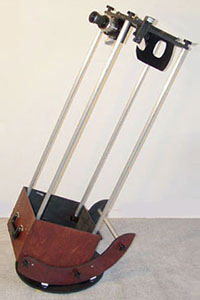 |
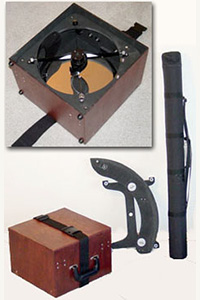 |
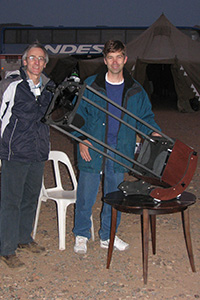 |
I was inspired
in part by
Steve Swayze who took an 8 inch to
the 1998 Caribbean Eclipse and by
Mel
Bartels 6 inch that went to Africa for the 2001 Eclipse. Both Telescopes were light and clever.
A traveling "Dob" has been in consideration for many years.
|
|
Telescope Page Menu |
|
My
Current Telescopes
My Past Reflector Telescopes
My Trend Settting Dobs
My Past Refractor Telescopes for Beginners Amatuer Telescope Links |
|
|
|
|
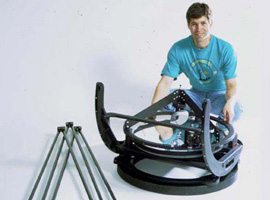 |
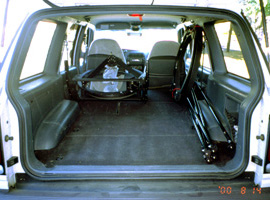 |
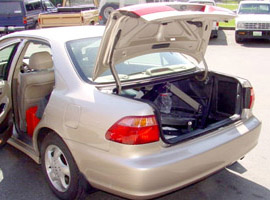 |
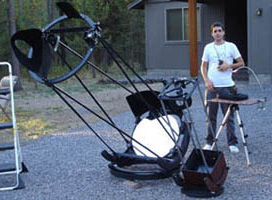 |
|||||
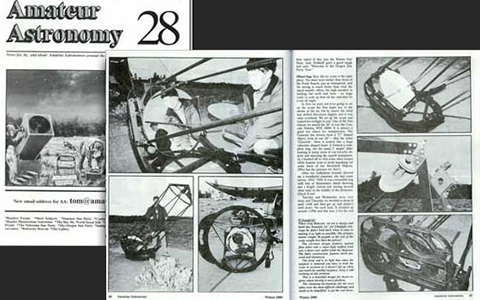 |
 |
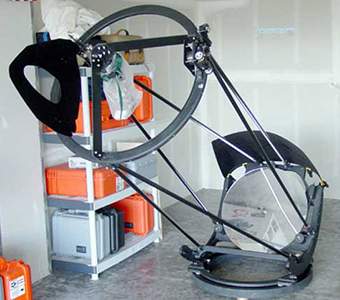 |
||
|
|
| The Ultra-Light / Minimalist / Large Bearing Concepts are NOT new. |
 |
 |
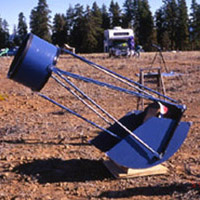 |
 |
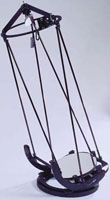 |
 |
||
| 1979 | 1980 1980 | 1997 | 1998 | 2000 | 1970 Cave Optical 16 inch | ||
|
Canadian Micheal
Taylor's 15 inch featured in June 1979 Sky & Telescope Magazine |
My 12 inch Concept |
Scott
Beard's 17.5 inch Large Bearing Dobsonian |
My 18 inch Ultra Light |
My 24 inch Ultra Light |
The
dwarfed 24 inch gathers twice the light. Pictured: Larry Hardin of Hardin Optical in Bandon, OR |
|
The tubing and plates were supplied
by Imitation is the greatest form of flattery... At the 2000 OSP walk about, I suggested that no one should try to take on this design because it is a lot of Aperture carried by few, yet reinforced components. I expected the radical nature of the design would preclude almost everyone from wanting to build it and blogs would rip it for its open design that seemingly leaves the Mirror unprotected. Yet many Amateurs have built similar models. Seven years after my Telescope's First Light, Obsession introduced versions and others followed. It has, unintentionally, become my "signature design." |
| Where is the 24 inch now? | ||
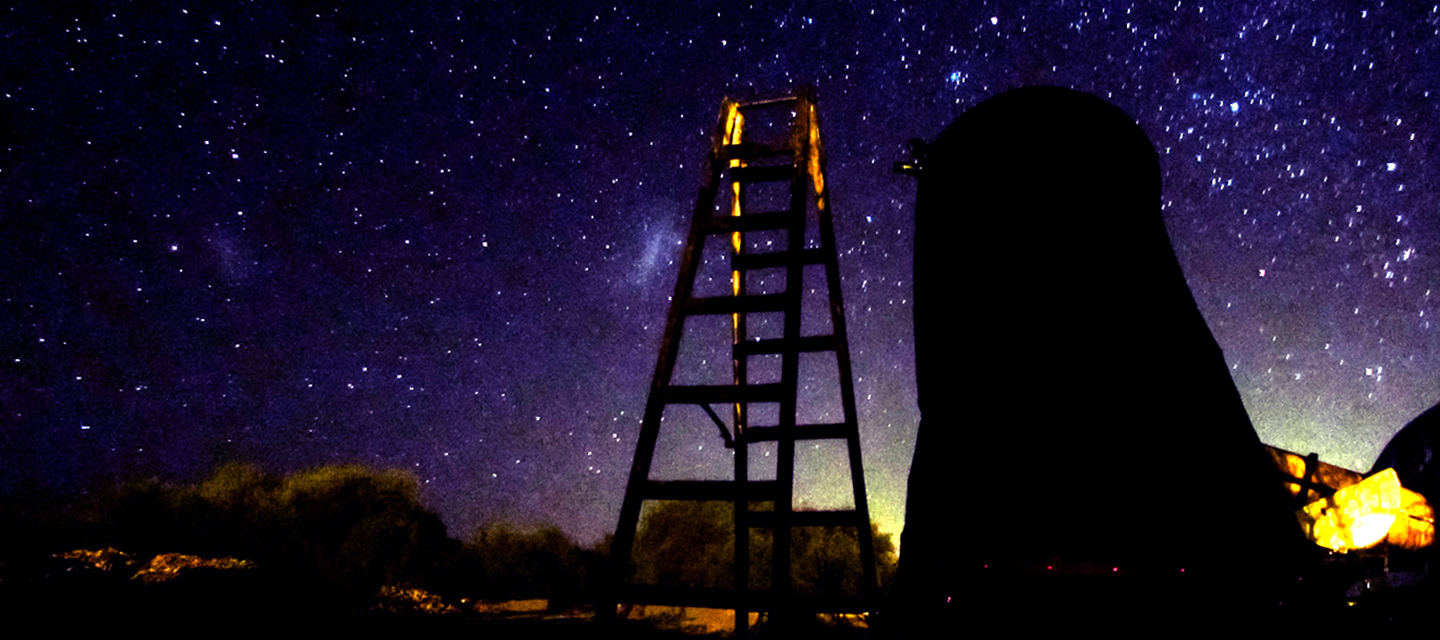 |
||
| The Telescope resides in Argentina, under the care of Leonardo Cavagnaro | ||
|
|
|
|
18 inch f/4.55 Ultra Light Dobsonian (custom built-homemade) |
First Light: Saturday, June 6th,
1998, 8:38pm.
Traded in 2000 for the 24 inch Mirror |
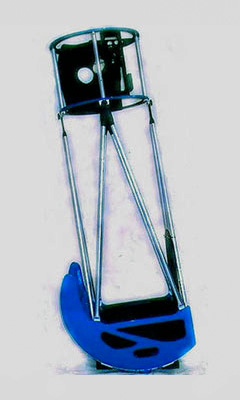 |
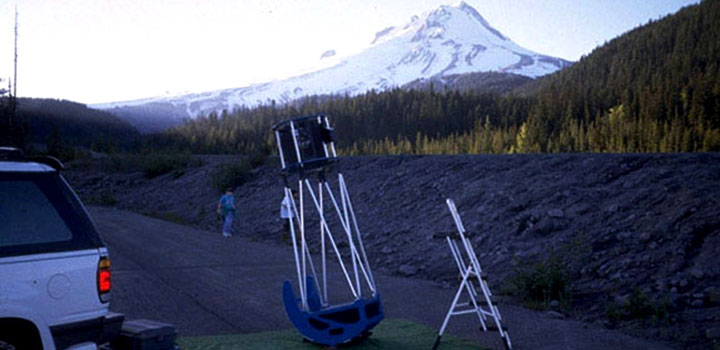 |
This Telescope was my first Dobsonian. It is a combination of Mel
Bartel's 20 inch and Scott Beard's rebuilt 17.5 inch Coulter. This Telescope made the large bearing design
popular.
It fits snuggly in almost any size vehicle and still leaves room for
camping provision. It weighs just 85 pounds.
The primary appeal of the design was the simplicity of the Mirror
box being the Altitude bearings instead of a box.
It is made of Baltic Birch with a marine coating. Trusses are Aluminum. It has a
conventional Cage, built by Chuck Detloff. The Mirror is a 2 inch
Thick Pyrex made by Swayze Optical. The idea originated from NEED the need to transport a large telescope in a small vehicle to a favorite observing site while still having room for a passenger and gear. Canadian Michael Taylor's 15 inch Telescope (see image) fits in a small car. His Telescope inspired me to study minimalist designs starting in 1979. Most innovative design Award July 1998 Table Mountain WA Star Party. |
||
|
Telescope Page Menu |
|
My
Current Telescopes
My Past Reflector Telescopes
My Trend Settting Dobs
My Past Refractor Telescopes for Beginners Amatuer Telescope Links |
|
|
|
|
Early Reflectors-the Iron Pipe era |
| 10 inch f/5 Torque Tube (custom built-homemade) Built 1977 -Sold 1979 |
 |
 After the Telescope was sold in
1979 to Lynn Carroll,
Mel
Bartels improved the Mount by
constructing and installing "Sector Drives". After the Telescope was sold in
1979 to Lynn Carroll,
Mel
Bartels improved the Mount by
constructing and installing "Sector Drives". |
I was fascinated by an
article is Sky & Telescope that discussed different Equatorial
Mountings. It spoke highly of the "Torque Tube" design.
A design used by Boller &
Chivens for their research Telescopes.
The "Tube" rotates around the outside of the Right Ascension
(RA) Axis and places the counter weight to the rear of the
Mount, removing encumbrances t the observer.
The Telescope can rotated 360
degrees around the Axis.
The mounting was built out of iron plumbing
pipe. The Telescope weighed 140 pounds. 40 pounds of that
was the counter weight. Images below: Left: Cut-a-way sketch of the Torque Tube Mount. The Torque Tube Mount, encouraged me to explore other "extended arm" Mounts. The center image are of mock-ups of 14.25 inch Telescopes using "Single Arm" Fork Mount designs. The Telescopes were never built, but several mounts were built. Right Image: This mount was originally sold to the "Eugene School Distric" (ESD) in 1978 and later re-sold to Tom Conlin for his 16 inch Telescope. It showed up at the 2008 Oregon Star Party (OSP). |
||||
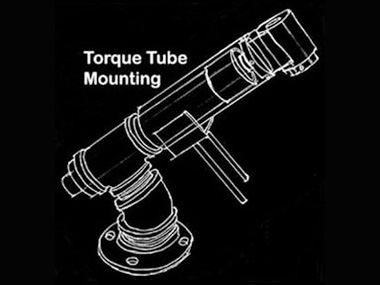 |
 |
||
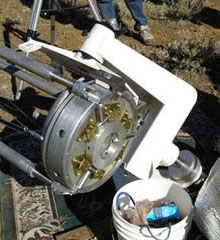 |
|||
|
At the 2008 Oregon Star Party |
|||
| Cut-a-way sketch | 14.25 inch Mockups using "Single Arm" Fork Mounts |
| . | |
| 4.25 inch f/4 Coulter Kit Newtonian Telescopes 1977 | |
 |
In the late 70s Coulter Optical came out with a Telescope kit for $49.95 that included a completed Primary Mirror and Secondary Mirror. The rest was fairly crude, but the Optics alone were worth the price. I buit several. They were an excellent "grab & go" Telescope. | |
| 8 inch f/7.1 Newtonian Telescope (custom built-homemade) Built 1972 - Sold 1976 |
| ... |
|
Telescope Page Menu |
|
My
Current Telescopes
My Past Reflector Telescopes
My Trend Settting Dobs
My Past Refractor Telescopes for Beginners Amatuer Telescope Links |
|
|
|
|
| My Past Refractor Telescopes |
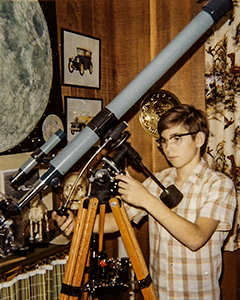 |
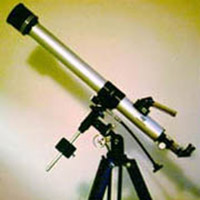 |
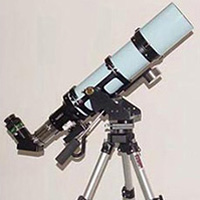 |
 |
 |
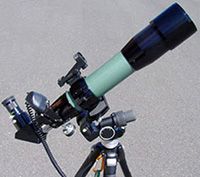 |
|||||
|
JC Penny 500x 60mm Me & my second Telescope December 1971 |
Jason 60 | Brandon 94 | Brandon 130 | Televue 70 Pronto | Televue 85 (TV 85) | |||||
| 94mm Brandon f/6.8 APO Refractors | ||||||
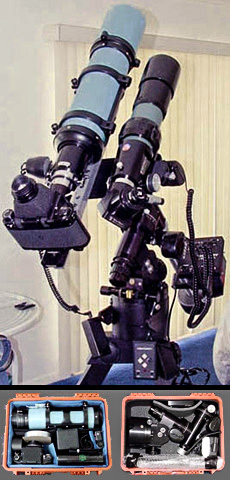 |
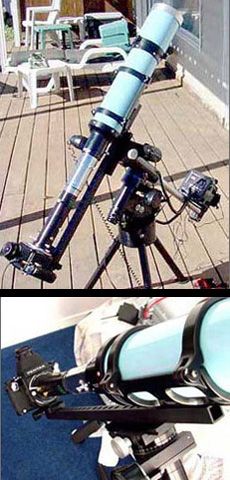 |
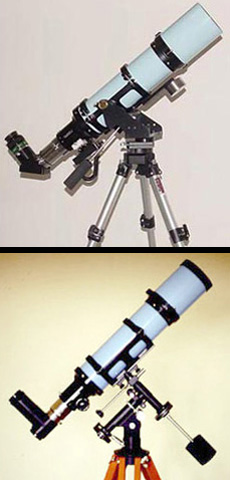 |
Refractors
have always filled a nitch the big Dobsonians can't fill.
They are portable good for "grab and go" purposes and they
are good for imaging.
I have owned two 94mm Brandon
Telescopes. I purchased the first in 1988. It was
responsible for bringing me back into Astronomy. With a 40mm
Konig Eyepiece, I had a 4.4 degree field of view and enjoy scanning
the sky and finding objects effortlessly. Aperture
feever soon took hold and I sold it in 1990 to fund the 130mm
Brandon purchase. The next 94mm Brandon was purchased in 1998 to replace the
70mm Pronto as my Eclipse Imaging Scope. It was used to image
the 1999 Eclipse. The optics in the Brandons
were made by Christian, currently of Astro Physics. It was
sold it in favor of using the much smaller and lighter TeleVue 76mm. |
|||
| . |
| . |
|
Telescope Page Menu |
|
My
Current Telescopes
My Past Reflector Telescopes
My Trend Settting Dobs
My Past Refractor Telescopes for Beginners Amatuer Telescope Links |
|
|
|
|
| for Beginners |
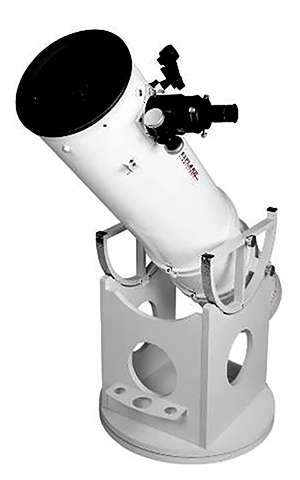 |
A Telescope for new & experienced Observers |
I do not recommend "goto" mounts for beginners. I like the concept, but they are often troublesome to operate. In reality, we still need to know the sky and what is worth looking at on a given night. That comes from websites, Apps, books, charts and experience. Dobsonians do not track, but you will find them easy to operate. Equatorial Mounts with their tarcking is nice to have, but can be expensive, and awkawrd to transport and setup. Often Equatorial Mounts are under-sized and by design can be very jiggly. For all of the above, I do not recommend an Equatorial Mount for Beginners. You should have no less than 3 to 4 good eyepieces (Plossls or better), including a good low power eyepiece. You will find that the lowest power is your favorite. Don't skimp on eyepieces. Many have told me that they want an Equatorial Mount for Imaging. Imaging is a field by its-self. I have seen the interest in imaging faulter as quickly as it came. And now the user is "stuck" with a cumbersome setup spoiling the spotanaity of observing on a given night. I recommend giving the casual observing a try first. For me, my observing is done with dedicated equipment. |
|||
|
Explore Scientific 8 inch f/6 Telescope |
|||||
|
For beginners
I recommend an 8 inch Dobsonian like the one shown or others similar.
The Dobsonian is excellent for beginners and experienced observers a
like.
They offer great value for the
cost. They assemble quickly and are easy to use. An 8 inch is a
serious aperture with almost twice the light gathering power of a 6
inch without adding a lot of weight or foot print or volume. It travels well in
small vehicles. An 8 inch provides a lot of bang for the
buck. |
|||||
. |
|||||
| ..... |
| . |
|
Telescope Page Menu |
|
My
Current Telescopes
My Past Reflector Telescopes
My Trend Settting Dobs
My Past Refractor Telescopes for Beginners Amatuer Telescope Links |
|
|
|
|
| Rich Field Observing |
| Home Built Sub f/4 Telescope Links |
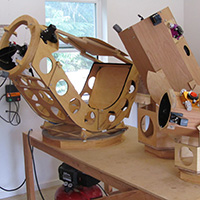 |
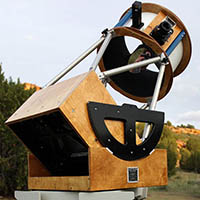 |
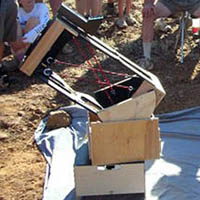 |
|
 |
||||
| Mel Bartels fleet of f/3s |
Lockwood 14.25 f/2.6 |
Ken Lulay 8 inch f/3.8 |
Ward-Pekurar 12 inch f/2.8 |
Swayze 10 inch f/3 |
||||
| The joy of Rich Field Telescopes (RFT) | ||||
| The Veil Nebula is 3 degrees in diameter. I consider it a standard for tarketing field of view with a Rich Field Dedicated set up. Image Courtsey of Peter Pekurar, maker of the Hobbit. 3 degrees = 6 Moon diameters. |
 |
|||
|
Telescope Page Menu |
|
My
Current Telescopes
My Past Reflector Telescopes
My Trend Settting Dobs
My Past Refractor Telescopes for Beginners Amatuer Telescope Links |
